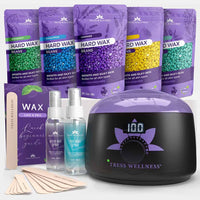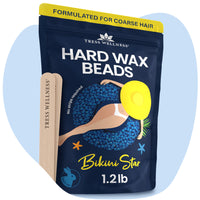Waxing can be a painful experience, and it varies from person to person. Some people have a higher pain tolerance, while others find waxing quite uncomfortable. If you're someone who feels the sting more than others, this blog is for you. Here are some detailed tips to help make your waxing sessions as painless as possible, turning painful waxing into painfree waxing.
Pick Your Perfect Wax
Choosing the right wax can significantly reduce discomfort during your waxing session. Here’s how to select the best wax for different body parts and skin types:
- Soft Wax: Ideal for large areas like legs and arms. It is spread thinly over the skin and removed with a cloth strip. It can be more painful for sensitive areas because it adheres to both hair and skin.
- Hard Wax: Perfect for sensitive areas such as the bikini line, underarms, and face. It hardens on the skin and is removed without a strip, making it gentler because it grips only the hair, not the skin. The Tress Wellness Waxing Kit includes premium hard wax beads that melt quickly and spread easily, designed to reduce pain and irritation.
- Speciality Waxes: Some waxes are formulated for specific skin types or concerns, such as the Bikini Star Beads, formulated especially for sensitive skin and sensitive areas like bikini, Brazilian and face waxing. Choosing the right formula can help minimize pain and prevent adverse reactions.

Selecting the appropriate wax type and formula for your needs ensures a smoother and more pain free waxing experience.
Pre-Wax Prep Like a Pro
Preparation is key to minimizing pain during waxing. Here's how to get your skin ready:
- Exfoliate: Gently exfoliate the area a day before waxing to remove dead skin cells and prevent ingrown hairs. Use a mild scrub or a dry brush.
- Cleanse: Clean your skin thoroughly to remove any oils, lotions, or sweat. This helps the wax adhere better to your hair.
- Trim Your Hair: Ensure your hair is about a quarter-inch long. If it's too long, trim it down. This makes the waxing process more efficient and less painful.
Apply Wax in Small, Manageable Sections

Applying wax in small, manageable sections is crucial for controlling pain and achieving effective hair removal. Here’s a detailed approach to sectioning:
- Divide the Area: Mentally divide the area you’re waxing into smaller sections. For example, if you're waxing your legs, break it down into parts like the upper thigh, lower thigh, upper calf, and lower calf. For the bikini area, you can segment into the upper bikini line, sides, and inner areas.
- Thin, Even Layers: Apply a thin, even layer of wax in the direction of hair growth. This ensures the wax grips the hairs properly and makes removal smoother. Avoid applying wax too thickly, as it can become difficult to remove and increase pain.
- Leave a Gripping Edge: When applying hard wax, make sure to leave a slightly thicker edge at the end of the section. This creates a “lip” that you can grab easily, ensuring a clean pull and reducing the need to reapply wax.
- Work Methodically: Start from one end of the area and move methodically to cover each section. This prevents missing spots and ensures even hair removal. Working in small sections allows for more control, reducing the likelihood of breaking hair or causing unnecessary pain.
By breaking down the waxing process into smaller sections, you can manage pain better and achieve a more precise, thorough hair removal.
Breathe Easy and Relax
Staying calm and relaxed can significantly impact your pain perception. Here's how to use breathing techniques to your advantage:
- Deep Inhale: Take a deep breath in through your nose for a count of four.
- Hold: Hold the breath for a count of four.
- Quick Exhale: Exhale quickly through your mouth as the wax strip is removed.
This controlled breathing helps to reduce anxiety and distracts you from the discomfort, turning painful waxing into a more manageable experience. Additionally, creating a comfortable environment with calming music and a warm, well-lit room can make the process more pleasant.
Numb the Area
If you find waxing particularly painful, consider using a numbing cream or gel. Apply it to the area about 30-45 minutes before waxing. These products can desensitize the skin, making the process more bearable and closer to painfree waxing.
Avoid Repeating the Same Spot
Repeatedly waxing the same spot can cause irritation and increased pain. If you miss some hairs, it's better to tweeze them afterward than to reapply wax. Waxing the same area multiple times can also damage the skin and cause bruising. This is one of the key reasons painful waxing experiences happen, so avoid this by being precise and careful with your application.
Regular Waxing: A Long-Term Solution

Consistency is key when it comes to making waxing less painful. Here’s how regular waxing can help:
- Thinner, Sparser Hair: With regular waxing, hair grows back finer and sparser over time. This is because waxing removes hair from the root, weakening the hair follicles. Thinner hair is easier to remove and less painful to wax.
- Reduced Sensitivity: Your skin becomes accustomed to the process with each session, reducing overall sensitivity. The first few times might be the most painful, but subsequent sessions should be more comfortable.
- Longer Hair-Free Periods: Regular waxing means you’ll enjoy longer periods of smooth, hair-free skin. This can reduce the frequency of waxing sessions and the associated discomfort.
- Routine Maintenance: Establishing a regular waxing schedule, such as every 4-6 weeks, helps maintain the results and ensures hair is at the optimal length for waxing, which is about a quarter-inch. This consistency prevents hair from becoming too long and painful to remove.
By committing to a regular waxing routine, you can make each session more bearable and maintain smooth skin with minimal discomfort.
Stay Hydrated and Calm
Staying hydrated and calm can significantly influence your pain threshold and overall experience. Here’s why and how:
- Hydrated Skin: Well-hydrated skin is more pliable and less likely to break or tear during waxing. Drinking plenty of water in the days leading up to your waxing session ensures your skin remains supple, making hair removal smoother and less painful.
- Avoid Caffeine and Alcohol: On the day of your waxing session, avoid consuming caffeine and alcohol. These substances can dehydrate your skin and increase sensitivity, making the waxing process more painful.
- Relaxation Techniques: Stress and tension can heighten your perception of pain. Practice relaxation techniques before and during your waxing session to keep calm. For instance, deep breathing exercises can help:
- Deep Inhale: Take a deep breath in through your nose for a count of four.
- Hold: Hold the breath for a count of four.
- Quick Exhale: Exhale quickly through your mouth as the wax strip is removed.
- This controlled breathing helps to reduce anxiety and distracts you from the discomfort.
- Comfortable Environment: Create a comfortable environment for your waxing session. Ensure the room is warm and well-lit, play calming music, and wear loose, comfortable clothing to make the process more pleasant.
By staying hydrated, avoiding substances that increase sensitivity, and practicing relaxation techniques, you can significantly reduce the pain associated with waxing.
Post-Wax Care is Key
Aftercare is crucial for soothing your skin and preventing irritation. Here are some steps to follow:
- Cool Compress: Apply a cool compress or soothing gel to calm the skin and reduce redness.You can also use the Tress Wellness after-wax spray.
- Avoid Heat: Stay away from hot showers, saunas, and direct sunlight for at least 24 hours post-waxing.
- Moisturize: Keep your skin hydrated with a gentle, fragrance-free moisturizer.
- Avoid Tight Clothing: Wear loose clothing to prevent friction and irritation on the waxed area.
Conclusion
Waxing doesn’t have to be a dreaded experience. By following these tips and choosing the right products, you can significantly reduce discomfort and enjoy smoother skin. Remember, everyone’s pain tolerance is different, and finding what works best for you is key. Happy waxing!




